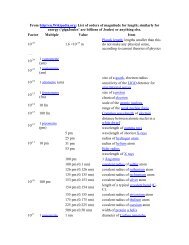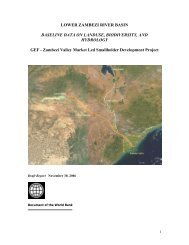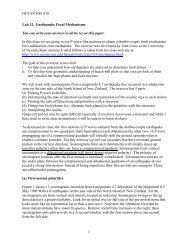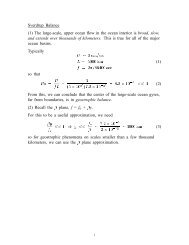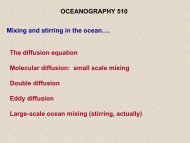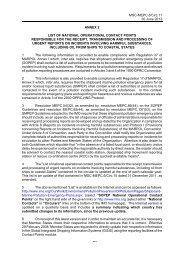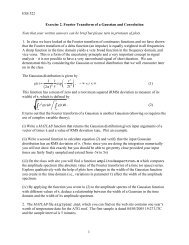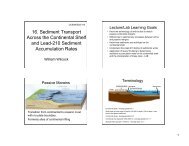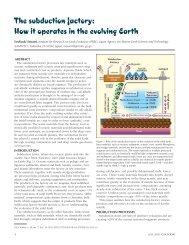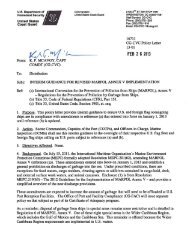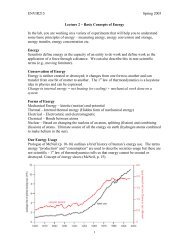2012 Seafloor Geodesy in Cascadia - William Wilcock - University of ...
2012 Seafloor Geodesy in Cascadia - William Wilcock - University of ...
2012 Seafloor Geodesy in Cascadia - William Wilcock - University of ...
Create successful ePaper yourself
Turn your PDF publications into a flip-book with our unique Google optimized e-Paper software.
improve the sensitivity <strong>of</strong> bathymetry time-‐differenc<strong>in</strong>g techniques to a level where they <br />
could detect <strong>in</strong>terseismic deformation. <br />
Where do we want to measure it? <br />
It was agreed that there should be a phased approach to the deployment plan. The first <br />
phase would start with an exploratory period, last<strong>in</strong>g on the order <strong>of</strong> 5 years, dur<strong>in</strong>g which <br />
various potential sources can be surveyed and <strong>in</strong>strumentation can undergo technical <br />
development. In the second phase, the density <strong>of</strong> observations would <strong>in</strong>crease with the <br />
ultimate goal <strong>of</strong> match<strong>in</strong>g those on land and with an <strong>in</strong>creased emphasis on monitor<strong>in</strong>g <br />
objectives. <br />
Figure 8. Schematic configuration <strong>of</strong> <br />
an <strong>in</strong>itial seafloor geodetic <br />
experiment based on the discussions <br />
<strong>of</strong> one work<strong>in</strong>g group. Several <br />
measurements (yellow) would be <br />
obta<strong>in</strong>ed mid-‐plate to constra<strong>in</strong> plate <br />
convergence rates. Trench-perpendicular<br />
geodetic pr<strong>of</strong>iles (red) <br />
would be obta<strong>in</strong>ed at several sites <br />
distributed along the entire <br />
subduction zone and would use <br />
campaign style deployments where <br />
cabled observatory <strong>in</strong>frastructure <br />
was presently unavailable. Additional <br />
pr<strong>of</strong>iles could be obta<strong>in</strong>ed with a f<strong>in</strong>er <br />
along-‐trench spac<strong>in</strong>g (black) to <br />
<strong>in</strong>vestigate segmentation (Base map <br />
created by the Center for <br />
Environmental Visualization, <br />
<strong>University</strong> <strong>of</strong> Wash<strong>in</strong>gton). <br />
Observations should be obta<strong>in</strong>ed at several more locations on the Juan de Fuca plate to <br />
measure plate motion and convergence rates. With<strong>in</strong> the subduction zone, there was a <br />
consensus that the <strong>in</strong>itial geodetic observations should be obta<strong>in</strong>ed on trench <br />
perpendicular transects. Each transect should <strong>in</strong>clude at least one site on the <strong>in</strong>com<strong>in</strong>g <br />
plate and should extend close to shore so that seafloor observations can be merged <br />
seamlessly with land measurements. The optimal spac<strong>in</strong>g <strong>of</strong> sites should be guided by <br />
model<strong>in</strong>g but would likely be 20-‐40 km. Each group envisioned between 4 and 10 <br />
transects whose location would be <strong>in</strong>formed by the structure <strong>of</strong> the prism, known seismic <br />
activity, and evidence <strong>of</strong> segmentation (Figure 8). Some transects can take advantage <strong>of</strong> <br />
the cabled observatories but a higher density <strong>of</strong> measurements is required along and <br />
across strike than can be supported exclusively by exist<strong>in</strong>g <strong>in</strong>frastructure. In addition to <br />
the transects, a few more dispersed observations will be required on the Juan de Fuca plate <br />
to constra<strong>in</strong> plate motion and <strong>in</strong>ternal deformation. <br />
17



